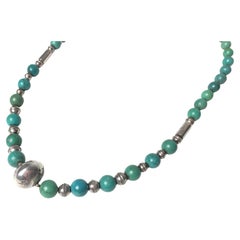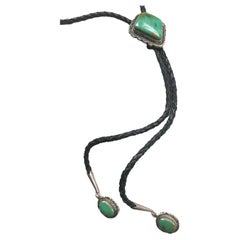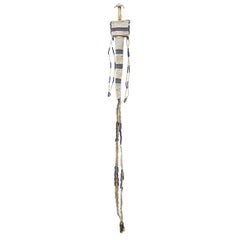Sioux Indian Art Furniture
Color: Gray
Creator: Sioux Indian Art
19th Century Sioux Quilled Hair Drop
By Sioux Indian Art
Located in Coeur d'Alene, ID
Sioux hair drop with brass trade beads, blue beaded background having red and yellow geometric designs. White horsehair drop dyed blue.
Period: Last quarter of the 19th century
Orig...
Category
Late 19th Century American Native American Antique Sioux Indian Art Furniture
Materials
Other
Related Items
Vintage Native American Zuni Necklace Earring Set Sterling Turquoise Jewellery
Located in London, GB
Vintage Native American Zuni Necklace Earring Set Sterling Turquoise
Silver and Turquoise beads with earrings set
Circa 1960 `s
length 60 cm 24 inches
...
Category
20th Century American Sioux Indian Art Furniture
Materials
Silver
Free Shipping
H 23.63 in W 1.19 in D 0.4 in
Vintage Native American Navajo Bolo Tie Sterling Turquoise Jewelry Gifts
Located in London, GB
A handsome hand-crafted Navajo design Bolo tie in sterling silver with blue green turquoise
circa 1960s.
With plaited black leather tie and sterling & turquoise tips.
Measures: 2 x ...
Category
20th Century American Sioux Indian Art Furniture
Materials
Silver
Free Shipping
H 1.58 in W 1.19 in D 0.4 in
Rare 19th Century English Tunbridgeware Hair Pin or Slide
Located in Dallas, TX
Presenting an absolutely gorgeous and extremely unique and rare 19th century British Tunbridgeware hair pin/bobbin or slide.
This slide is unlike any of it’s kind we have seen before…. it is a very rare survivor !
From circa 1860–1880.
Made of walnut with gorgeous marquetry inlay on the entirety of the front with classic Tunbridgeware micro-mosaic all over the front. The rear is walnut.
The marquetry inlay appears to be various different woods, namely, maple, walnut and satinwood.
Would have been worn in a Lady’s hair bun with the micro-mosaic facing forward.
This would have belonged to a very elegant lady in the mid to late 19th century.
Tunbridge ware is a form of decoratively inlaid woodwork, typically in the form of boxes, that is characteristic of Tonbridge and the spa town of Royal Tunbridge Wells in Kent in the 18th and 19th centuries. The decoration typically consists of a mosaic of many very small pieces of different coloured woods that form a pictorial vignette. Shaped rods and slivers of wood were first carefully glued together, then cut into many thin slices of identical pictorial veneer with a fine saw. Elaborately striped and feathered bandings for framing were pre-formed in a similar fashion.
There is a collection of Tunbridge ware in the Tunbridge Wells Museum and Art Gallery in Tunbridge Wells.
The famous makers of Tunbridge ware were in the Tunbridge Wells area of Kent; their most notable work was from circa 1830-1900.
Early makers of Tunbridge ware, in Tunbridge Wells in the mid-18th century, were the Burrows family, and Fenner and Co. In the 19th century, around 1830, James Burrows invented a technique of creating mosaics from wooden tesserae. Henry Hollamby, apprenticed to the Burrows family, set up on his own in 1842 and became an important manufacturer of Tunbridge ware, employing about 40 people.
Edmund Nye (1797–1863) and his father took over the Fenner company when William Fenner retired in 1840, after 30 years in partnership with him. Thomas Barton (1819–1903), previously apprenticed at the Wise factory, joined the Nyes in 1836, and worked as Nye’s designer; he took over the business in 1863 and continued there until his death.
In Tonbridge (near to Tunbridge Wells), George Wise (1703–1779) is known to have had a business in 1746. It continued with his son Thomas, and Thomas’s nephew George (1779–1869), who took over in 1806. In its early years the company made articles such as workboxes and tea caddies with prints of popular views; later items had pictures created from mosaics. Their workshop in Tonbridge, Wise’s Tunbridge Ware Manufactory, was next to the Big Bridge over the Medway; the building was demolished in 1886 to widen the approach to the bridge.
Tunbridge ware became popular with visitors to the spa town of Tunbridge Wells, who bought them as souvenirs and gifts. Articles included cribbage boards, paperweights, writing slopes, snuffboxes and glove boxes.
At the Great Exhibition of 1851, Tunbridge ware by Edmund Nye, Robert Russell and Henry Hollamby was shown; Edmund Nye received a commendation from the judges for his work. He exhibited a table depicting a mosaic of a ship at sea; 110,800 tesserae were used in making the picture.
The manufacturers of Tunbridge ware were cottage industries, and they were no more than nine in Tunbridge Wells and one in Tonbridge. The number declined in the 1880s; competent craftsmen were hard to find, and public tastes changed. After the death of Thomas Barton in 1903 the only surviving firm was Boyce, Brown and Kemp, which closed in 1927.
Marquetry was an old technique which was continued by Nye and Barton to create images such as birds or butterflies.
‘Green Oak’ as caused by the fungus Chlorociboria aeruginascens.
Stickware and half-square mosaic was invented by James Burrows in about 1830: a bunch of wooden sticks of different colours, each having triangular or diamond-shaped cross section, were tightly glued together; in the case of stickware, the resulting block was dried, then turned to form an article such as the base of a pincushion. For half-square mosaic, thin slices were taken from the composite block, and applied to a surface.[1][2][4]
Tesselated mosaic, was a development by James Burrows of half-square mosaic; it was adopted by George Wise and Edmund Nye. Minute tesserae were used to form a wide variety of geometric and pictorial designs.
Many sorts of wood were used for the various colours; about 40 were in regular use. Only natural colors were used; green was provided by “green oak”, produced by the action of fungus on fallen oak. Designs for articles were often taken from designs of Berlin wool work.
Category
Late 19th Century English High Victorian Antique Sioux Indian Art Furniture
Materials
Satinwood, Walnut
Vintage Native American Navajo Zuni Ring Kachina Dancer silver Turquoise
Located in London, GB
A exquisite vintage Zuni Native American silver ring with inlaid Kachina dancer
This silver ring features a Kachina dancer inlaid with T...
Category
20th Century American Sioux Indian Art Furniture
Materials
Silver
Free Shipping
H 5 in W 5 in D 8.5 in
Large Vintage Native American Navajo silver Turquoise squash blossom necklace
Located in London, GB
Fine quality large hand crafted Vintage Native American Navajo sterling silver and Turquoise squash blossom necklace.
In the classic Navajo Silver squash blossom design with blue gr...
Category
20th Century American Sioux Indian Art Furniture
Materials
Silver
H 15.75 in W 3.94 in D 0.79 in
Native American Indian Doll with Traditional Lakota Sioux Cherokee Wedding Dress
Located in Vero Beach, FL
Native American Indian doll with traditional Lakota Sioux Cherokee wedding dress with bead-work, one of a kind
This is an authentic Native American, Am...
Category
1980s North American Native American Vintage Sioux Indian Art Furniture
Materials
Clay, Leather
H 17 in W 7 in D 4 in
Large Vintage Native American Navajo Ring Turquoise silver
Located in London, GB
A fine vintage handcrafted Large Native American Navajo Ring Turquoise silver
A particularly fine and attractive Navajo ring with multiple small turquoise cabochons
Makers initia...
Category
20th Century American Sioux Indian Art Furniture
Materials
Silver
Vintage Chunky Navajo South West Native American Silver Turquoise Nugget ring
Located in London, GB
Chunky Vintage Navajo South West Native American Silver Turquoise ring
with large Turquoise nugget,
adjustable size
Conditi...
Category
20th Century American Sioux Indian Art Furniture
Materials
Silver
Free Shipping
H 5 in W 5 in D 8.5 in
19th Century Native American Corn Husk Plateau Bag
Located in Los Angeles, CA
This very fine exceptional early 19th century native American Indian corn husk plateau bag. Fine condition with a fantastic patch repair on one side.
Category
19th Century American Adirondack Antique Sioux Indian Art Furniture
Materials
Wool
Indigenous Sheyka Sterling Silver and Inlaid Figural Rabbit Brooch or Pendant
By Native American Art
Located in Hamilton, Ontario
This Zuni Indigenous American sterling silver and inlaid gemstone figural rabbit brooch or pendant was made by Porfillo and Ann Sheyka. The piece was handmade in most likely the late...
Category
Mid-20th Century American Mid-Century Modern Sioux Indian Art Furniture
Materials
Multi-gemstone, Sterling Silver
H 1.5 in W 2 in D 0.25 in
Sterling Silver Native American Indian Motif "Note Holder" American, Circa 1880
Located in Incline Village, NV
Very rare and unusual piece, a sterling silver "note holder" fronted by an Indian Chief on the front in high relief. A bale on top provides for a necklace and hanging as a decorative...
Category
1880s American Native American Antique Sioux Indian Art Furniture
Materials
Sterling Silver
H 2.88 in W 2 in D 0.35 in
Sterling Turquoise Bolo Tie by Teddy Goodluck
Located in Toledo, OH
Sterling Turquoise bolo tie by Teddy Goodluck. Extra large Sterling Bolo. Beautiful stone that measures 2.5" x 1.75" with tooled front with overall ...
Category
Late 20th Century Sioux Indian Art Furniture
Materials
Sterling Silver
Previously Available Items
19th Century Native American Yanktonai Sioux Beaded Belt
By Sioux Indian Art
Located in Coeur d'Alene, ID
Yanktonai Sioux at Fort Peck fully beaded sinew sewn belt on brain tanned buffalo. Greasy yellows and red white hearts. As worn condition with a few edge bea...
Category
Late 19th Century American Native American Antique Sioux Indian Art Furniture
Materials
Beads
Antique Native American Beaded Awl Case, Sioux 'Plains Indian, ' 19th Century
By Sioux Indian Art
Located in Denver, CO
Antique 19th century Native American Sioux (Plains Indian) beadwork woman's awl case constructed of native tanned hide, sinew-sewn with trade beads in white, dark blue, Pony-Trader b...
Category
Late 19th Century American Native American Antique Sioux Indian Art Furniture
Materials
Hide
H 20.5 in W 2 in D 0.75 in
Antique Native American Indian Beaded Moccasins, Sioux, Late 19th Century
By Sioux Indian Art
Located in Denver, CO
Constructed from native tanned hide with red trade cloth and glass trade beads in intricate designs including stylized tepees on a classic blue Sioux background.
A nomadic tribe, th...
Category
19th Century American Native American Antique Sioux Indian Art Furniture
Materials
Hide
H 3.75 in W 3.75 in D 10 in
Sioux Indian Art furniture for sale on 1stDibs.
Sioux Indian Art furniture are available for sale on 1stDibs. These distinctive items are frequently made of animal skin and are designed with extraordinary care. There are many options to choose from in our collection of Sioux Indian Art furniture, although beige editions of this piece are particularly popular. If you’re looking for additional options, many customers also consider furniture by Plateau Indians, Navajo Indian Art, and Apache Indian Art. Prices for Sioux Indian Art furniture can differ depending upon size, time period and other attributes — on 1stDibs, these items begin at $1,850 and can go as high as $35,000, while a piece like these, on average, fetch $5,250.
Creators Similar to Sioux Indian Art
Questions About Sioux Indian Art Furniture
- 1stDibs ExpertMay 3, 2024The father of modern Indian art is generally thought to be Raja Ravi Varma. Active during the late 18th and early 19th centuries, he was the first Indian artist widely known for producing paintings that depicted Indian subjects using the techniques of the European masters. Some of his most famous works include Bhishma on a Bed of Arrows, Bharat Mata, Jatayu Vadham and Lady in the Moonlight. On 1stDibs, shop a variety of Indian art.




